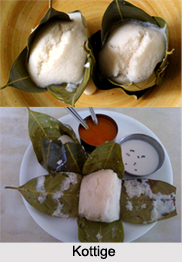 Kottige is essentially idli batter steamed in mini leaf baskets woven out of Jackfruit leaves strategically placed and pinned together with sharp pieces of broomstick. The Jackfruit leaves lend a lovely flavour and fragrance to these Idlis and the taste is unmatched with the regular Idli. It is usually a festive preparation made by Mangalorean Hindus but is available all year round in some hotels in Mangalore. "Kottige" is also known as "Khotto" and it is called as "Gunda" in Konkani. Kottige is usually served in the hotels for breakfast; it is usually paired with "Chutney" and "Sambhar". Nowadays people don"t spend time in making these baskets as these baskets are available readily made in Mangalore market.
Kottige is essentially idli batter steamed in mini leaf baskets woven out of Jackfruit leaves strategically placed and pinned together with sharp pieces of broomstick. The Jackfruit leaves lend a lovely flavour and fragrance to these Idlis and the taste is unmatched with the regular Idli. It is usually a festive preparation made by Mangalorean Hindus but is available all year round in some hotels in Mangalore. "Kottige" is also known as "Khotto" and it is called as "Gunda" in Konkani. Kottige is usually served in the hotels for breakfast; it is usually paired with "Chutney" and "Sambhar". Nowadays people don"t spend time in making these baskets as these baskets are available readily made in Mangalore market.
Ingredients for Batter:
•Raw Rice - 2 cups
•Urad Dal - 1 cup
•Salt to taste
Ingredients for Leaf Baskets:
•Jackfruit Leaves - 24 large
•Broomsticks/wooden toothpicks - as many as required
Method to prepare Baskets:
1. Take 4 equal sized jackfruit leaves and place 2 leaves with the corners (not the stem side) slightly overlapping on each other and join them with a piece of small stick.
2. Now place the 3rd and 4th leaf and again join them at the edges with the help of the sticks.
3. Now fold the corners such that the side edges of the leaves overlap on each other and leaves no gap in between, pin the overlapped portion carefully so that there would not be any leakage of the batter while steaming.
4. Repeat for all the edges and pin together to form a basket.
Method to make Kottige:
1. Wash and soak the rice and urad dal separately for at least 3 to 4 hours.
2. Grind the urad dal first to a fine paste.
3. Transfer to a large pan that will hold it for fermentation.
4. Next, grind the rice with very little water to an almost Rawa like texture.
5. Add this to the urad paste and mix well.
6. Add a little water if required to bring the batter to a dosa batter like consistency.
7. Cover the mouth of the vessel with a muslin cloth and keep in a warm place overnight or for 7 to 8 hours for fermentation.
8. Add salt to taste, mix well and pour batter into the prepared jackfruit leaf baskets till about 3/4th of the basket is full.
9. Steam for 15 to 20 minutes.
10. Serve hot with Curry or green chutney or sambhar or chutney powder.
Tips for Kottige
While opening tear the leaves carefully so that the Kottige can slip out of the basket without getting stuck to the leaves and loose its shape. Do not overcrowd the steamer with the baskets while steaming but make sure there is not much of gap in between the baskets.




















